Book contents
- Frontmatter
- Contents
- Contributors
- Introduction
- Convergence of Numerical Schemes for Degenerate Parabolic Equations Arising in Finance Theory
- Continuous-Time Monte Carlo Methods and Variance Reduction
- Recent Advances in Numerical Methods for Pricing Derivative Securities
- American Options: A Comparison of Numerical Methods
- Fast, Accurate and Inelegant Valuation of American Options
- Valuation of American Option in a Jump-diffusion Models
- Some Nonlinear Methods for Studying Far-from-the-money Contingent Claims
- Monte Carlo Methods for Stochastic Volatility Models
- Dynamic Optimization for a Mixed Portfolio with Transaction Costs
- Imperfect Markets and Backward Stochastic Differential Equations
- Reflected Backward SDEs and American Options
- Numerical Methods for Backward Stochastic Differential Equations
- Viscosity Solutions and Numerical Schemes for Investment/Consumption Models with Transaction Costs
- Does Volatility Jump or Just Diffuse? A Statistical Approach
- Martingale-Based Hedge Error Control
- The Use of Second-Order Stochastic Dominance To Bound European Call Prices: Theory and Results
Recent Advances in Numerical Methods for Pricing Derivative Securities
Published online by Cambridge University Press: 05 June 2012
- Frontmatter
- Contents
- Contributors
- Introduction
- Convergence of Numerical Schemes for Degenerate Parabolic Equations Arising in Finance Theory
- Continuous-Time Monte Carlo Methods and Variance Reduction
- Recent Advances in Numerical Methods for Pricing Derivative Securities
- American Options: A Comparison of Numerical Methods
- Fast, Accurate and Inelegant Valuation of American Options
- Valuation of American Option in a Jump-diffusion Models
- Some Nonlinear Methods for Studying Far-from-the-money Contingent Claims
- Monte Carlo Methods for Stochastic Volatility Models
- Dynamic Optimization for a Mixed Portfolio with Transaction Costs
- Imperfect Markets and Backward Stochastic Differential Equations
- Reflected Backward SDEs and American Options
- Numerical Methods for Backward Stochastic Differential Equations
- Viscosity Solutions and Numerical Schemes for Investment/Consumption Models with Transaction Costs
- Does Volatility Jump or Just Diffuse? A Statistical Approach
- Martingale-Based Hedge Error Control
- The Use of Second-Order Stochastic Dominance To Bound European Call Prices: Theory and Results
Summary
Introduction
In the past two decades there has been an explosion in the use of derivative securities by investors, corporations, mutual funds, and financial institutions. Exchange traded derivatives have experienced unprecedented growth in volume while ‘exotic’ securities (i.e., securities with nonstandard payoff patterns) have become more common in the over-the-counter market. Using the most widely accepted financial models, there are many types of securities which cannot be priced in closed-form. This void has created a great need for efficient numerical procedures for security pricing.
Closed-form prices are available in a few special cases. One example is a European option (i.e., an option which can only be exercised at the maturity date of the contract) written on a single underlying asset. The European option valuation formula was derived in the seminal papers of Black & Scholes (1973) and Merton (1973). In the case of American options (i.e., options which can be exercised at any time at or before the maturity date) analytical expressions for the price have been derived, but there are no easily computable, explicit formulas currently available. Researchers and practitioners must then resort to numerical approximation techniques to compute the prices of these instruments. Further complications occur when the payoff of the derivative security depends on multiple assets or multiple sources of uncertainty. Analytical solutions are often not available for options with path-dependent payoffs and other exotic options.
- Type
- Chapter
- Information
- Numerical Methods in Finance , pp. 43 - 66Publisher: Cambridge University PressPrint publication year: 1997
- 27
- Cited by



